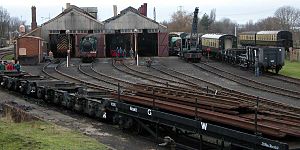Didcot Railway Centre

General view, including engine sheds, of part of the site
|
|
| Established | 1967 |
|---|---|
| Location | Didcot, Oxfordshire, England |
| Coordinates | 51°36′49″N 1°14′41″W / 51.613509°N 1.244772°WCoordinates: 51°36′49″N 1°14′41″W / 51.613509°N 1.244772°W |
| Type | Operational Railway museum |
| Key holdings |
GWR 6000 Class No.6023 King Edward II GWR 4073 Class No.4079 Pendennis Castle GWR Firefly Class Firefly |
| Owner | Great Western Society (site leased from Network Rail) |
| Public transit access | Didcot Parkway |
| Website | Didcot Railway Centre |
Didcot Railway Centre is a former Great Western Railway engine-shed and locomotive stabling point located in Didcot, Oxfordshire, England, which today has been converted into a railway museum and preservation engineering site.
The founders and commercial backers of the GWR supported Isambard Kingdom Brunel's schema to develop an integrated railway and steam-ship service which allowed trans-Atlantic passengers and freight quicker passage to and from London to New York City. However, whilst backing the scheme the railway had to make a profit, and so it took a number of detours and added both mainline and branchline traffic to increase its domestic earnings. This earned the railway the nickname The Great Way Round from its detractors.
Whilst the route from London Paddington to Reading was relatively straight, the then obvious most direct route to Bristol would have taken the railway further south, thus avoiding both Didcot and Swindon. However, passenger and freight traffic both to and from Oxford and onwards to the West Midlands in part dictated a more northerly route. Secondly Brunel had originally planned to cut through Savernake Forest near Marlborough, Wiltshire to Bristol, but the Marquess of Ailesbury, who owned the land, objected - having previously objected to part of the Kennet and Avon Canal running through his estate (see Bruce Tunnel). With the railway needing to run near to a canal at its midpoint - as it was cheaper to transport coal for trains along canals at this time - and with need for the branch northwards to Cheltenham via Stroud, Swindon was the next logical choice for the junction (and later railway works), 20 miles (32 km) north of the original route. This dictated that the Oxford junction also be moved northwards, and hence via Didcot. The Great Western Railway built the first rail line through Didcot in 1839 and opened its first station in 1844.
...
Wikipedia
